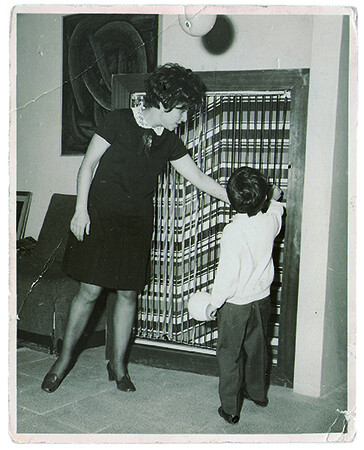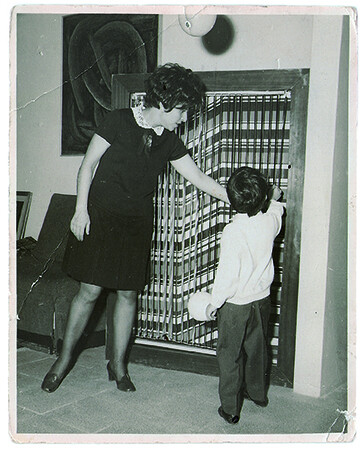Behjat Sadr
Trace through the Black
January 22–February 12, 2016
Opening: January 22, 3–9pm
Ab/Anbar Gallery
No.2 Roshanmanesh alley
Khaghani St., Enghelab St.
Darvazeh Dolat
Tehran
Iran
Hours: Sunday–Friday 12–8pm
Curated by Morad Montazami
Ab/Anbar announces Behjat Sadr: Trace through the Black, a comprehensive solo exhibition spanning over four decades of the renowned Iranian modernist painter’s oeuvre, which will take place at both Ab/Anbar and Aria galleries.
Behjat Sadr: Trace through the Black explores her artistic and intellectual heritage, with archival material, and presenting a rare selection of masterpieces: from her early debate with “abstraction informelle” in the 1950s; to her experimentations around organic forms, trace making, and hallucinatory networks of lines throughout the 1960s and 1970s; up until her “collage” years throughout the (inner) exile and the irrepressible return to her world of futuristic nostalgia.
Sadr is regarded as one of Iran’s most influential and radical Modern painters, due to her abstract paintings of paradoxical traces that blend luxuriant nature with the sharp-edged industrial. Sadr developed this signatory language in the 1950s, bringing together European Modernism and a modernity in Iran. A pioneer of the visual arts in Iran, she was one of the first women artists and professors to appear on the international biennial scene in the early 1960s. Sadr offers the singular testimony of a nascent cosmopolitan modernity that emerged in Tehran, Rome and Paris, in cities where she studied and exhibited, embodying an extraordinary fusion of work and life.
The influence and legacy of Behjat Sadr as artist, teacher and pioneer of women’s art in Iran and internationally, is a result of her commitment to introducing new ideas to painting through her impressionist-gestural approaches. An approach which led to creating canvases with serene or violent marks on surfaces that allowed for an exploration between the artist’s body and its movement around the surrounding floor space. This performative approach to painting was one she described as “an uncontrollable urge to put her canvases on the floor allowing for the making of larger moves, and offering a greater control over gestures.”
An extended edition in Farsi of the publication Behjat Sadr: Traces (Zamân Books) will be available for sale during the opening of the exhibition.
Behjat Sadr (1924–2009)
After studying at the faculty of fine arts at the University of Tehran, Behjat Sadr went to Rome, where she graduated toward abstract painting and informal art. Leaving frames and traditional colours behind, she used synthetic industrial paints that she ran on supports placed on the ground. Her works have been exhibited in many institutions internationally including Galleria La Bussola, Rome (1958); Venice Biennale (1956, 1962); Musée d’Art moderne de la Ville de Paris (1963, 2014); Grey Foundation, Saint Paul, Minnesota (1971); Musées royaux des Beaux-Arts de Belgique, Brussels (1972); Centre d’art Le Noroît, Arras, France (1985); Grey Art Gallery, New York (2010); Asia Society, New York (2013–14); MAXXI Rome (2014–15). In 2004, the Tehran Museum of Contemporary Art (TMOCA) devoted a large retrospective to her, as part of the series devoted to pioneers of modern art in Iran.
Morad Montazami
Morad Montazami is adjunct research-curator at Tate Modern, for the Middle East and North Africa, supported by the Iran Heritage Foundation. He is the author of several articles and essays on artists including Farid Belkahia, Bahman Mohassess, Behdjat Sadr, Hamed Abdalla, Jordi Colomer, Jeremy Deller, Francis Alÿs, Zineb Sedira, Allan Sekula and Walid Raad. He was a co-curator for the exhibition Unedited History: IRAN 1960–2014 at Musée d’art Moderne de la Ville de Paris and MAXXI, Rome. He is the editor-in-chief of the journal Zamân and director of the publishing house ZAMAN BOOKS.
For image requests, interviews and more information about Ab/Anbar: press [at] ab-anbar.com



